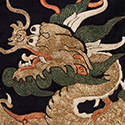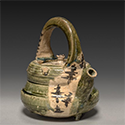|
|
| Show All 58 Results (Text Only) |
|
| Amazing Tangka Stories |
|
| American Museum of Natural History
|
An Interactive website presenting two sets of Tibetan tangkas: Jataka Tales (past life stories of the Buddha) and Dipankara Atisha (famous Indian Buddhist monk). The tangkas are shown with their original Tibetan inscriptions and English translation(viewers can click on sections of each painting and see the story)The paintings that depict stories (avadanas) of exemplary people as told by the Buddha who fulfill the Buddhist ideal of the Bodhisattva, a person who always gives whatever he or she can to help others. Through such generosity, over many lifetimes, they will become enlightened. The Buddha tells each story and at its end he identifies the main characters in their present life, that is, as his own contemporaries. In some cases these are past life stories (jatakas) of the Buddha.
Go to Museum Resource: https://anthro.amnh.org/tangka_stories | |
|
|
| The Artful Fabric of Collecting |
|
| Jordan Schnitzner Museum of Art, University of Oregon
|
Chinese textiles from the collection of Gertrude Bass Warner (1863-1951), who… was particularly drawn to silk textiles and the people who produced them, primarily the women in private households and commercial workshops. Techniques and patterns of weaving silk for Chinese robes are demonstrated on the site. It was only in the 17th century when the production of court orders began to overwhelm the imperial workshops that commercial workshops took over some of the production. In these commercial workshops, most of them located in the Jiangnan area, the center of China’s silk production, male weavers relegated women to the groundworks of silk production: the rearing of the silkworms and reeling the silk of the cocoons. Embroidery remained the domain of women. They were the master embroiderers who developed the art to its height in the Qing Dynasty (1644-1911). Their legacy can be admired in the textiles from the Warner collection.
Go to Museum Resource: https://glam.uoregon.edu/s/fabric-of-collecting/page/welcome | |
|
|
|
| Arts of the Samurai [PDF] |
|
| Asian Art Museum of San Francisco
|
"The term samurai is derived from the word saburau, or “one who serves.” The evolution of the samurai from mounted guards to the nobility (during the twelfth century) and their subsequent ascent to military leaders of Japan (until imperial restoration during the nineteenth century) is chronicled in distinctive warrior arts and literary tradition. This packet examines the samurai through precious art objects from the museum’s collection. These include authentic military equipment (arms and armor), paintings depicting famed conflicts, ceremonial attire, and objects created for religious and cultural pursuits strongly connected with the samurai class."
Go to Museum Resource: https://education.asianart.org/wp-content/uploads/sites/6/2019/12/ArtsofSamurai... | |
|
|
| The Asian Art Digital Teaching Project: Japan |
|
| Columbia University, Media Center for Art History
|
A module for "classroom presentation or student study" of two important scrolls from the Kamakura Period – Illustrated Legends of the Kitano Shrine (Kitano Tenjin Engi) and Illustrated Sutra of the Miracles of Kannon.
Go to Museum Resource: http://www.learn.columbia.edu/nehasian/html/neh_geo_con_japan.html | |
|
|
|
| Bu and Bun: The Arts of War and Peace |
|
| Asian Art Museum of San Francisco
|
In addition to superior strategic and military ability, most elite samurai were expected to be versed in the cultural arts. The warrior’s ideal balance of military and artistic skill is captured well in this description of the sixteenth century daimyo Hosokawa Yusai (1534–1610): “Renowned for his elegant pursuits, he is a complete man combining arts [bun] and arms [bu]. A man of nobility, a descendant of the sixth grandson of the emperor Seiwa, he was a ruler endowed with awesome dignity and inspiring decorum…He built a splendid castle, which was majestic, beautiful and high…He discussed Chinese poetic styles and recited by heart the secret teachings of Japanese poetry…" See also Archery Practice.
Go to Museum Resource: https://education.asianart.org/resources/bu-and-bun-the-arts-of-war-and-peace/ | |
|
|
| Chado: The Japanese Tea Ceremony |
|
| The Cleveland Museum of Art
|
This lesson introduces students to the Japanese tea ceremony to consider the art and the tradition of the tea ceremony and study the serving pieces used in the ceremony by participating in a tea ceremony. Students will learn the importance of the performance of tea ceremony through the history of how it became what it is today.
Go to Museum Resource: http://www.clevelandart.org/lesson-plan-packet/chado-japanese-tea-ceremony | |
|
|
|
| Show All 58 Results (Text Only) |









